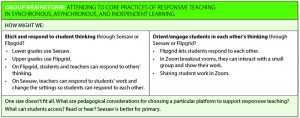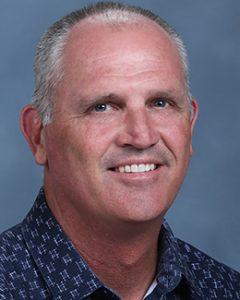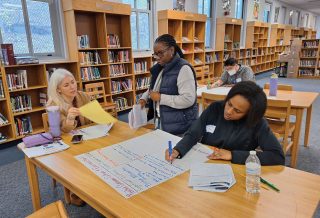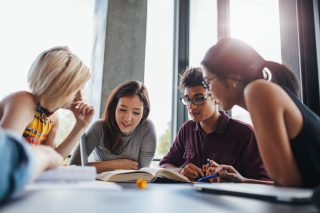FOCUS
Learning together when you're apart
By Jody Guarino, Rossella Santagata, Jiwon Lee, Duane Cox and John Drake
Categories: Change management, Collaboration, College- and career-ready standards, Learning communities, Learning systems/planning, Online learningJune 2020
Vol. 41, No. 3
Like many others around the world, we have moved our busy lives and our research-practice partnership to the planet of distal learning and remote working. While the news about the spreading of the pandemic and the dire economic consequences entered our homes, we did not want to lose what had brought us together in partnership this year: a focus on collaborative and responsive teaching and learning.
In August 2019, our group of researchers and local school district educators joined a collaboration between the University of California, Irvine and the Orange County Education Advancement Initiative. Our problem of practice was how to create a vision for student-centered instruction.
Working primarily at Rea Elementary School in the Newport-Mesa Unified School District, we centered our partnership on schoolwide improvements in mathematics. In this effort, we agreed to collaborate to transform what often is the individual journey of a teacher trying to improve his or her teaching into the efforts of a community of learners.
As we unexpectedly moved into distance learning in March, a new problem of practice emerged: How could we maintain our focus on responsive math teaching and learning, while also adapting to teaching in ways that none of us had ever experienced? How would we continue to be a community of learners in settings unfamiliar to many of us?
In a short time, we have learned a lot about how to maintain our collaborative work through distance learning. We tell our story of transition to distance learning here not to share best practices, but to narrate our learning together and offer an opportunity for others to reflect on their own journeys during these challenging times.
Maintaining community and familiar routines
Because our effort to improve instruction relies on working together as a community of learners, we knew that maintaining our connections would be essential. We re-created the collaboration routines we had used in our in-person meetings during the year: working in small groups, generating ideas, and sharing out to learn together. The only difference was that we weren’t physically together.
Before the move to distance learning, Wednesday afternoons were sacred staff time. The staff met weekly for one hour, with one of these hourly sessions per month focusing on mathematics teaching. We decided to keep this structure in place during distance learning. We planned our first session around the importance of connecting with one another and re-creating our collaborative learning community online.
Our first synchronous online learning experience began with team members viewing a slide with several images expressing various emotions and, in small breakout groups, sharing which image(s) they identified with and why. This offered an opportunity to reconnect on a personal level and think about the importance of connecting, not only with each other but also with students and students connecting with each other.
Next, we continued our tradition of doing math together, which we believe is an important way of experiencing our instruction from the perspective of our students. We engaged in the activity that had launched our work back in August: counting collections. In small breakout groups of five to six people, we asked everyone to take a picture of something in their homes that they could count and upload the image into a slide deck.
We thought doing this activity was important to re-create a sense of familiarity for students and families. Children had engaged in counting collections several times at school, and families had become familiar with the activity at a family math night at the school site. Counting collections also allowed children to share images of things in their homes that were important to them, which could provide reassurance during this stressful time.
Working together, we found a way to communicate to students and families that counting can happen anywhere and homes can be transformed into classrooms. Each week, we collaborate on other strategies, growing our repertoire. As Leina Dingle, a 2nd-grade teacher at Rea, said, “[The weekly sessions] give me more ideas on how to connect to my students and have students show their work.”
Establishing a shared instructional vision
Early in our work together, we had realized the importance of creating a professional vision for student learning. Now we recognized the need to develop a shared idea of what distance learning experiences could look like and sound like to continue communicating our vision of high-quality math instruction.
We realized that distance learning could happen in three ways (depending on access to technology and connectivity). Student learning at home can be synchronous, asynchronous, or independent with limited or no technology. We needed to be ready to offer inclusive experiences tailored to the affordances and challenges of each.
This led to collective problem-solving around each format (see tables on pp. 44 and 45). We brainstormed what teaching and learning could look like in each approach, allowing space for unanswered questions and evolving thoughts. Then we brainstormed how to maintain the principles of responsive teaching that we’ve been developing all year in each type of learning. We shared ideas about specific technology platforms that could be helpful for each.
In these conversations, teacher voice and agency have been important, just as student voice and agency are important in teachers’ work. During our weekly staff meetings, teachers share artifacts of their work (e.g. pictures, images, student responses) through slides and screenshares. As Myuriel Von Aspen, who supports Rea and other schools in her role as teacher on special assignment in Newport-Mesa Unified School District, put it, “I think the more we learn together, we can be more responsive to students. As we learn together, we can support each other. We can have the same language and goals. And all this helps us to be more supportive and responsive to our students.”
During each staff meeting, we highlight and celebrate the work being done and create a space to learn with and from each other. We also include teacher input and exit surveys in every session. The feedback is shared with everyone. This allows us to make visible to teachers the process of planning we engage in, modeling for them responsive instruction. It is designed to encourage teachers to make feedback, input, and voice a central part of their work with students.
Learning from a student perspective
We can’t teach effectively with a tool unless we have learned with it ourselves first. This is especially important as we implement new technology.
In a recent experience, Rick Costello, a 5th-grade teacher at Rea, created a math story problem for us to solve and explain in short videos using Flipgrid. We then watched each other’s videos and commented. We experienced the role of students learning to use Flipgrid.
Next, we worked in teams to consider the affordances and limitations of online platforms with student learning and thinking as a priority. Two core practices of responsive teaching guided our final discussion: eliciting and responding to student thinking and engaging students in each other’s thinking (see table on p. 45).
Each week, new ideas, wonderings, and lessons emerge. For example, a few hours after this meeting, we all received an email from another teacher with a screencast of how to do even more with Flipgrid, building on what we had done together. The sense of urgency to respond to the emergency has amplified collaborative efforts. Teachers have taken even more active roles, sharing their efforts and leading meetings.
Working with the technology ourselves before using it with students also allows us to anticipate challenges and be prepared with strategies for solving them. We can empathize with students and families who were learning to navigate new spaces and try new things, and we can identify challenges before they occur with students.
For example, the counting collections experience revealed some of the challenges that likely lay ahead of us with students. When we launched the task, group members immediately had many questions about how to upload a picture to an online slide deck, something we did not anticipate.
Some members tried to help by saying, “Here’s my phone number. Text me the image, and I’ll upload it for you.” But when they received messages with images, they were from unfamiliar numbers, and there was confusion about whose picture was whose. In less than a minute, we saw the importance of engaging in the work ourselves before asking teachers to do it with students.
We reflected on what kinds of things we would need to consider in asking elementary school children to complete similar tasks. As Nancy Vera, a 1st-grade teacher at Rea, explained, “These sessions have … allowed me to put myself in my students’ shoes to understand what they are experiencing with distance learning.”

Leading for learning
Through this year’s work on responsive teaching in mathematics, the role of school and district leaders has been crucial. From the outset, leaders eschewed the kind of top-down direction, evaluative feedback, and directive communication that is often typical in school settings. Instead, they joined the teachers and students as learners. At Rea Elementary, it’s not unusual to see a lesson co-taught by a classroom teacher, assistant superintendent, and math coordinator, or to observe students solving problems and sharing their thinking with not only their own classroom teacher, but also teachers from other classrooms, a university researcher, or the principal.
During distance learning, leaders at Rea have asked: How do we continue this focus on collaborative teaching and learning? Principal Duane Cox, whose active participation in all learning spaces has shaped the culture of learning at Rea Elementary, continues to share his infectious enthusiasm for learning and attention to individual students’ learning.
Cox maintains the school’s long-term goals and vision while making sure that logistics are taken care of to free up time for teachers to focus on learning. In times of crisis, leadership can unfortunately default to directing and controlling, but Cox continues to work as facilitator of the community of learners.
He begins every staff session as he has since the beginning of the school year, with words of encouragement and support. He reminds his teachers about the importance of continuing to look at, talk about, and learn from student work.
Recently, the 1st-grade team met on Zoom. Based on student work they had collected the day before, the teachers discussed their students’ mathematical thinking, knowledge, and abilities associated with two-digit addition and agreed the students are ready to focus on subtraction.
They developed a story problem for all 1st-graders to engage in the coming week. The principal and the math coordinator will participate in synchronous online learning experiences alongside 1st-grade teachers and students. At its next meeting, the group will share and discuss what they learned from student work.
A community path
Through all of our work, we strive to continue our focus on equity and improve how we connect with children and their families during these extremely challenging times. Our focus remains on student learning. Cristina Kuehn, 2nd-grade teacher at Rea, sums it up by saying, “It’s really cool to see that we were able to still do CGI [cognitively guided instruction] even though it’s distance learning. It’s been really fun to see the kids still thriving and still totally understanding … in this kind of situation.”
We aspire to extend this work to other schools in the district by engaging school principals and district directors to join our community of learners. We are just at the beginning of our path for successful distance learning, and we have many unanswered questions ahead of us. For educators, as for students, questions are a vital part of growth, and there’s no better way to tackle them than in a community of learners.
Categories: Change management, Collaboration, College- and career-ready standards, Learning communities, Learning systems/planning, Online learning
Recent Issues
LEARNING DESIGNS
February 2025
How we learn influences what we learn. This issue shares essential...
BUILDING BRIDGES
December 2024
Students benefit when educators bridge the continuum of professional...
CURRICULUM-BASED PROFESSIONAL LEARNING
October 2024
High-quality curriculum requires skilled educators to put it into...
LEARNING TO PIVOT
August 2024
Sometimes new information and situations call for major change. This issue...














